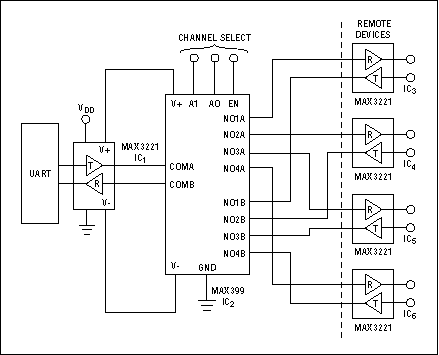RS-232 communicaTIons with one µC and more than one remote system can be problemaTIc, because most µCs contain only one UART, which provides an interface between synchronous and asynchronous ports. The mulTIplexer in the figure below, IC2 , allows multiple channels (four, in this case) to share a single UART. The dual four-to-one multiplexer permits transceiver IC1 to form a network with the four remote transceivers IC3 to IC6. The table that follows defines the channel-selection codes. Selecting Channel 1, for instance, enables IC1 to communicate with IC3 without being loaded by IC4 to IC6. Pulldown resistors inside the remote transceivers force the outputs of unselected receivers to a known state.

One UART and one multiplexer enable one RS-232 transceiver to communicate with four others.
Channel Selection Codes
| Selected channel | A1 | A0 | EN |
| All channels disconnected | X | X | 0 |
| Channel 1 (IC3) | 0 | 0 | 1 |
| Channel 2 (IC4) | 0 | 1 | 1 |
| Channel 3 (IC5) | 1 | 0 | 1 |
| Channel 4 (IC6) | 1 | 1 | 1 |
The circuit's supply-voltage range (3V to 5.5V) makes it compatible with 3V and 5V logic. IC2 receives its power directly from the V+ and V- terminals of IC1, whose ±5.5V outputs come from an internal charge pump. The multiplexer handles rail-to-rail signals, so obtaining its power from IC1 ensures that RS-232 signals pass directly through, regardless of amplitude. Each transceiver's charge pump requires four small capacitors (not shown), whose values depend on the VDD range but do not exceed 0.47µF. Note that pulling too much current from the charge-pump terminals of IC1, V+ and V-, can cause these rails to droop and can pull the IC's RS-232 transmission levels out of specification.
A similar version of this article appeared in the September 28, 2000 issue of EDN.